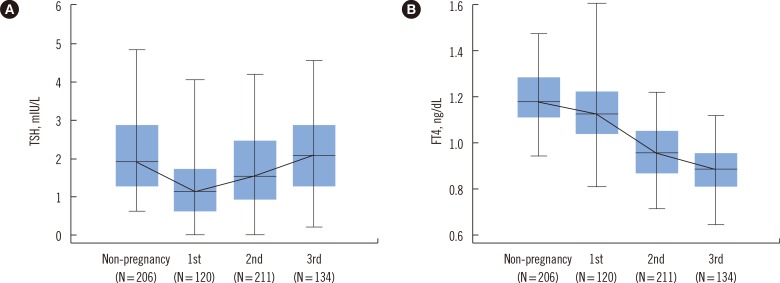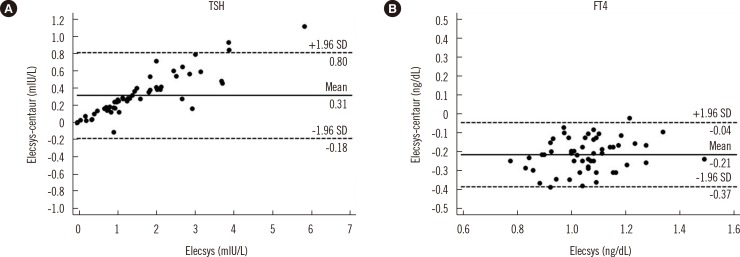Establishment of Trimester-Specific Reference Intervals for Thyroid Hormones in Korean Pregnant Women
- Affiliations
-
- 1Department of Laboratory Medicine, Konkuk University School of Medicine, Seoul, Korea. ymyun@kuh.ac.kr
- 2Department of Laboratory Medicine, Cheil General Hospital and Women's Healthcare Center, Kwandong University College of Medicine, Seoul, Korea.
- 3Department of Laboratory Medicine, Dongnam Institute of Radiological and Medical Sciences, Busan, Korea.
- KMID: 2363179
- DOI: http://doi.org/10.3343/alm.2015.35.2.198
Abstract
- BACKGROUND
Establishment of trimester- and assay-specific reference intervals for every population is recommended. The aim of this study was to establish a trimester- and assay-specific reference interval for thyroid-stimulating hormone (TSH) and free thyroxine (FT4) in Korean pregnant women.
METHODS
From April 2012 to December 2012, 531 pregnant women receiving prenatal care and 238 age-matched, non-pregnant women were enrolled in this study. After excluding patients with pregnancy-associated complications or thyroid-specific autoantibody, 465 pregnant and 206 non-pregnant women were included. Non-parametric analysis (2.5-97.5th percentile) was performed to determine the reference interval. Levels of TSH and FT4 were determined by electrochemiluminescence immunoassay (Elecsys thyroid tests, Roche Diagnostics, Germany).
RESULTS
The TSH reference intervals were 0.01-4.10, 0.01-4.26, and 0.15-4.57 mIU/L for the first, second, and third trimester, respectively. From the first trimester to the third trimester, the median TSH levels showed a significantly increasing trend (P<0.0001). The FT4 reference intervals were 0.83-1.65, 0.71-1.22, and 0.65-1.13 ng/dL for the first, second, and third trimester, respectively, showing a significantly decreasing trend (P<0.0001).
CONCLUSIONS
Establishing trimester-specific reference intervals in pregnant women is essential for accurate assessment of thyroid function. Our population-specific and method-specific reference intervals will be useful for screening Korean pregnant women for thyroid disease.
MeSH Terms
Figure
Cited by 6 articles
-
Recent Issues Related to Thyroid Disease in Pregnancy
Jae Hoon Chung
Int J Thyroidol. 2020;13(2):85-94. doi: 10.11106/ijt.2020.13.2.85.Thyroid-Stimulating Hormone Reference Ranges in the First Trimester of Pregnancy in an Iodine-Sufficient Country
Carmen Castillo, Nicole Lustig, Paula Margozzini, Andrea Gomez, María Paulina Rojas, Santiago Muzzo, Lorena Mosso
Endocrinol Metab. 2018;33(4):466-472. doi: 10.3803/EnM.2018.33.4.466.Subclinical Hypothyroidism: Prevalence, Health Impact, and Treatment Landscape
Won Sang Yoo, Hyun Kyung Chung
Endocrinol Metab. 2021;36(3):500-513. doi: 10.3803/EnM.2021.1066.2023 Revised Korean Thyroid Association Guidelines for the Diagnosis and Management of Thyroid Disease during Pregnancy and Postpartum
Ka Hee Yi, Hwa Young Ahn, Jin Hwa Kim, So Young Park, Won Sang Yoo, Kyong Yeun Jung, Eun Kyung Lee, Young Joo Park, Sun Wook Kim, Chang Hoon Yim, Yun Jae Chung, Ho-Cheol Kang, Do Joon Park
Int J Thyroidol. 2023;16(1):51-88. doi: 10.11106/ijt.2023.16.1.51.Diagnosis and Management of Thyroid Disease during Pregnancy and Postpartum: 2023 Revised Korean Thyroid Association Guidelines
Hwa Young Ahn, Ka Hee Yi
Endocrinol Metab. 2023;38(3):289-294. doi: 10.3803/EnM.2023.1696.Screening and Management of Thyroid Dysfunction During Pregnancy
Sul Lee, Seung-Chul Kim
J Korean Soc Matern Child Health. 2023;27(3):148-153. doi: 10.21896/jksmch.2023.27.3.148.
Reference
-
1. Casey BM, Dashe JS, Wells CE, McIntire DD, Byrd W, Leveno KJ, et al. Subclinical hypothyroidism and pregnancy outcomes. Obstet Gynecol. 2005; 105:239–245. PMID: 15684146.
Article2. Allan WC, Haddow JE, Palomaki GE, Williams JR, Mitchell ML, Hermos RJ, et al. Maternal thyroid deficiency and pregnancy complications: implications for population screening. J Med Screen. 2000; 7:127–130. PMID: 11126160.
Article3. Abalovich M, Gutierrez S, Alcaraz G, Maccallini G, Garcia A, Levalle O. Overt and subclinical hypothyroidism complicating pregnancy. Thyroid. 2002; 12:63–68. PMID: 11838732.
Article4. Haddow JE, Palomaki GE, Allan WC, Williams JR, Knight GJ, Gagnon J, et al. Maternal thyroid deficiency during pregnancy and subsequent neuropsychological development of the child. N Engl J Med. 1999; 341:549–555. PMID: 10451459.
Article5. Stagnaro-Green A, Abalovich M, Alexander E, Azizi F, Mestman J, Negro R, et al. Guidelines of the American Thyroid Association for the diagnosis and management of thyroid disease during pregnancy and postpartum. Thyroid. 2011; 21:1081–1125. PMID: 21787128.
Article6. Yan YQ, Dong ZL, Dong L, Wang FR, Yang XM, Jin XY, et al. Trimester- and method-specific reference intervals for thyroid tests in pregnant Chinese women: methodology, euthyroid definition and iodine status can influence the setting of reference intervals. Clin Endocrinol (Oxf). 2011; 74:262–269. PMID: 21044115.
Article7. Karakosta P, Chatzi L, Bagkeris E, Daraki V, Alegakis D, Castanas E, et al. First- and second-trimester reference intervals for thyroid hormones during pregnancy in "Rhea" mother-child cohort, crete, greece. J Thyroid Res. 2011; 2011:490783. PMID: 22175032.
Article8. Azizi F, Mehran L, Amouzegar A, Delshad H, Tohidi M, Askari S, et al. Establishment of the trimester-specific reference range for free thyroxine index. Thyroid. 2013; 23:354–359. PMID: 23167270.
Article9. Yu B, Wang QW, Huang RP, Cao F, Zhu ZQ, Sun DC, et al. Establishment of self-sequential longitudinal reference intervals of maternal thyroid function during pregnancy. Exp Biol Med (Maywood). 2010; 235:1212–1215. PMID: 20810761.
Article10. Kurioka H, Takahashi K, Miyazaki K. Maternal thyroid function during pregnancy and puerperal period. Endocr J. 2005; 52:587–591. PMID: 16284437.
Article11. Marwaha RK, Chopra S, Gopalakrishnan S, Sharma B, Kanwar RS, Sastry A, et al. Establishment of reference range for thyroid hormones in normal pregnant Indian women. BJOG. 2008; 115:602–606. PMID: 18333941.
Article12. Baloch Z, Carayon P, Conte-Devolx B, Demers LM, Feldt-Rasmussen U, Henry JF, et al. Laboratory medicine practice guidelines. Laboratory support for the diagnosis and monitoring of thyroid disease. Thyroid. 2003; 13:3–126. PMID: 12625976.13. Glinoer D. What happens to the normal thyroid during pregnancy? Thyroid. 1999; 9:631–635. PMID: 10447005.
Article14. Clinical and Laboratory Standards Institute. CLSI document C28-A. How to define and determine reference intervals in the clinical laboratory; approved guideline. Second edition. Wayne, PA: CLSI;2000.15. Taylor R. Interpretation of the correlation coefficient: a basic review. J Diagn Med Sonogr. 1990; 1:35–39.
Article16. Fantz CR, Dagogo-Jack S, Ladenson JH, Gronowski AM. Thyroid function during pregnancy. Clin Chem. 1999; 45:2250–2258. PMID: 10585360.
Article17. Dhatt GS, Jayasundaram R, Wareth LA, Nagelkerke N, Jayasundaram K, Darwish EA, et al. Thyrotrophin and free thyroxine trimester-specific reference intervals in a mixed ethnic pregnant population in the United Arab Emirates. Clin Chim Acta. 2006; 370:147–151. PMID: 16554043.
Article18. Panesar NS, Li CY, Rogers MS. Reference intervals for thyroid hormones in pregnant Chinese women. Ann Clin Biochem. 2001; 38:329–332. PMID: 11471873.19. Stricker R, Echenard M, Eberhart R, Chevailler MC, Perez V, Quinn FA, et al. Evaluation of maternal thyroid function during pregnancy: the importance of using gestational age-specific reference intervals. Eur J Endocrinol. 2007; 157:509–514. PMID: 17893266.
Article20. Gilbert RM, Hadlow NC, Walsh JP, Fletcher SJ, Brown SJ, Stuckey BG, et al. Assessment of thyroid function during pregnancy: first-trimester (weeks 9-13) reference intervals derived from Western Australian women. Med J Aust. 2008; 189:250–253. PMID: 18759718.
Article21. Surks MI, Boucai L. Age- and race-based serum thyrotropin reference limits. J Clin Endocrinol Metab. 2010; 95:496–502. PMID: 19965925.
Article22. Walker JA, Illions EH, Huddleston JF, Smallridge RC. Racial comparisons of thyroid function and autoimmunity during pregnancy and the postpartum period. Obstet Gynecol. 2005; 106:1365–1371. PMID: 16319264.
Article23. Hollowell JG, Staehling NW, Flanders WD, Hannon WH, Gunter EW, Spencer CA, et al. Serum TSH, T(4), and thyroid antibodies in the United States population (1988 to 1994): National Health and Nutrition Examination Survey (NHANES III). J Clin Endocrinol Metab. 2002; 87:489–499. PMID: 11836274.
Article24. La'ulu SL, Roberts WL. Second-trimester reference intervals for thyroid tests: the role of ethnicity. Clin Chem. 2007; 53:1658–1664. PMID: 17712003.25. Mehran L, Amouzegar A, Delshad H, Askari S, Hedayati M, Amirshekari G, et al. Trimester-specific reference ranges for thyroid hormones in Iranian pregnant women. J Thyroid Res. 2013; 2013:651517. PMID: 23841018.
Article26. Panesar NS. TSH levels in human pregnancy. Clin Endocrinol (Oxf). 2011; 75:406–407. PMID: 21521330.
Article27. Springer D, Zima T, Limanova Z. Reference intervals in evaluation of maternal thyroid function during the first trimester of pregnancy. Eur J Endocrinol. 2009; 160:791–797. PMID: 19228824.
Article28. Lambert-Messerlian G, McClain M, Haddow JE, Palomaki GE, Canick JA, Cleary-Goldman J, et al. First- and second-trimester thyroid hormone reference data in pregnant women: a FaSTER (First- and Second-Trimester Evaluation of Risk for aneuploidy) Research Consortium study. Am J Obstet Gynecol. 2008; 199:62.e1–62.e6. PMID: 18585522.
Article29. Sapin R, d'Herbomez M. Free thyroxine measured by equilibrium dialysis and nine immunoassays in sera with various serum thyroxine-binding capacities. Clin Chem. 2003; 49:1531–1535. PMID: 12928239.
Article30. Rawlins ML, Roberts WL. Performance characteristics of six third-generation assays for thyroid-stimulating hormone. Clin Chem. 2004; 50:2338–2344. PMID: 15472032.
Article31. Thienpont LM, Van Uytfanghe K, Beastall G, Faix JD, Ieiri T, Miller WG, et al. Report of the IFCC Working Group for Standardization of Thyroid Function Tests; part 2: free thyroxine and free triiodothyronine. Clin Chem. 2010; 56:912–920. PMID: 20395623.
Article32. Thienpont LM, Van Uytfanghe K, Beastall G, Faix JD, Ieiri T, Miller WG, et al. Report of the IFCC Working Group for Standardization of Thyroid Function Tests; part 1: thyroid-stimulating hormone. Clin Chem. 2010; 56:902–911. PMID: 20395624.
Article
- Full Text Links
- Actions
-
Cited
- CITED
-
- Close
- Share
- Similar articles
-
- Reference intervals of thyroid hormones during pregnancy in Korea, an iodine-replete area
- TSH and Free T4 Concentrations in Korean Pregnant Women
- Maternal Thyroid Function during the First Trimester of Pregnancy in Korean Women
- Thyroid-Stimulating Hormone Reference Ranges in the First Trimester of Pregnancy in an Iodine-Sufficient Country
- Thyroid Hormone Reference Intervals among Healthy Individuals In Lanzhou, China



